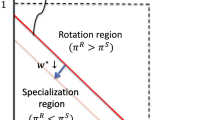Abstract
This paper examines conditions under which a demand-constrained, cost-minimizing firm will provide industry-specific on-the-job-training to its employees, when a flexible stock of outside labor is available for hire. The term industry-specific is used to describe training with general components valued by other firms in the industry. This definition of on-the-job-training offers the possibility that trained workers could be poached by competing firms and provides limited opportunities for newly trained workers to seek alternative employment. The firm's decisions involve whether or not to invest in on-the-job-training, and whether to use in-house labor exclusively or a mix of in-house and outside labor. The cost-minimizing strategy is crucially dependent upon the mutual loyalty of the firm and its workers.
Similar content being viewed by others
References
Altonji, Joseph G.; Spletzer, James R. "Worker Characteristics, Job Characteristics, and the Receipt of On-the-Job Training,"Industrial and Labor Relations Review, 45, 1, 1991, pp. 58–79.
Barron, John M.; Berger, M. C; Black, Dan A. "Do Workers Pay for On The Job Training?," Working Paper #E-16993, University of Kentucky, Center for Economic Research, 1993.
Barron, John M.; Black, Dan A.; Loewenstein, Mark A. "Job Matching and On-the-Job Training,"Journal of Labor Economics, 7, 1, 1989, pp. 1–19.
__. "Gender Differences in Training, Capital, and Wages,"Journal of Human Resources, 28, 2, 1993, pp. 343–64.
Becker, Gary. "Investment in Human Capital — A Theoretical Analysis,"Journal of Political Economy, 70, 5, 1962, pp. 9–49.
__. "Human Capital: A Theoretical and Empirical Analysis with Special Reference to Education," New York, NY: National Bureau of Economic Research, Columbia University Press, 1964.
Booth, Alison L. "Private Sector Training and Graduate Earnings,"Review of Economics and Statistics, 75, 1, 1993, pp. 164–70.
Brown, James N. "Why Do Wages Increase with Tenure? On-the-Job Training and Life-Cycle Wage Growth Observed within Firms,"American Economic Review, 79, 5, 1989, pp. 971–91.
Cooper, Helene. "The New Educators,"Wall Street Journal, October 5, 1992, p. 1.
Duncan, Greg J.; Hoffman, Saul. "On-the-Job Training and Earnings Differences by Race and Sex,"Review of Economics and Statistics, 61, 4, 1979, pp. 594–603.
Freeman, Richard. "Demand for Education," in Orley Ashenfelter; Richard Layard, eds.,Handbook of Labor Economics, Vol. 1, Handbooks in Economics series, no. 5, Amsterdam, Oxford, and Tokyo: North-Holland (distributed in North America by Elsevier Science, New York), 1986, pp. 357–86.
Hashimoto, Masanori. "Firm Specific Human Capital as a Shared Investment,"American Economic Review, 71, 3, 1981, pp. 475–82.
Jovanovic, Boyan. "Firm Specific Capital and Turnover,"Journal of Political Economy, 87, 6, 1979, pp. 1246–60.
Laing, Derek. "Firm Specific Human Capital as an Employer Discipline Device,"Economic Inquiry, 32, 1, 1994, pp. 128–37.
Lazear, Edward. "Agency, Earnings Profiles, Productivity and Hours Restrictions,"American Economic Review, 71, 4, 1981, pp. 606–20.
Lillard, Lee A.; Tan, Hong W. "Private Sector Training Who Gets It And What Are Its Effects?," in Erenberg ed.,Research in Labor Economics, Vol. 13, Greenwich, CT and London, England: JAI Press, 1992, pp. 1–62.
Lucas, Robert. "On the Mechanics of Economic Development,"Journal of Monetary Economics, 22, 1988, pp. 3–42.
Lynch, Lisa. "Private Sector Training and the Earnings of Young Workers,"American Economic Review, 82, 1, 1992, pp. 299–312.
__. "Payoffs to Alternative Training Strategies at Work," in Richard Freeman, ed.,Working Under Different Rules, NBER Research Project Report, Russell Sage Foundation, 1994, pp. 63–95.
Mincer, Jacob. "Investment in Human Capital and Personal Income Distribution,"Journal of Political Economy, 66, 4, 1958, pp. 281–302.
__. "On the Job Training Costs, Returns and Some Implications,"Journal of Political Economy, 75, 5, 1962, pp. 50–79.
__. "Job Training, Wage Growth, and Labor Turnover," National Bureau of Economic Research, Working Paper, 1988, p. 2690.
Mincer, Jacob; Polachek, Solomon. "Family Investment in Human Capital: Earnings of Women,"Journal of Political Economy, 82, 2, 1974, pp. S76–S108.
Neal, Derek. "Industry-specific Human Capital: Evidence from Displaced Workers,"Journal of Labor Economics, 13, 4, 1995, pp. 653–77.
Nickell, Steven J. "Dynamic Models of Labour Demand," in Orley Ashenfelter; Richard Layard, eds..Handbook of Labor Economics, Vol. 1, Handbooks in Economics series, no. 5, Amsterdam, Oxford, and Tokyo: North-Holland (distributed in North America by Elsevier Science, New York), 1986, pp. 473–522.
Parsons, Donald O. "The Firm's Decision to Train," in Laurie J. Bassi; David L. Crawford, eds.,Labor Economics and Public Policy. Research in Labor Economics, Vol. 11, Greenwich, CT and London, England: JAI Press, 1990, pp. 53–75.
Pergamit, Michael R.; Shack-Marquez, Janice "Earnings and Different Types of Training," Bureau of Labor Statistics Working Paper no. 165, 1987.
Romer, Paul M. "Capital, Labor, and Productivity,"Brookings Papers on Economic Activity, Special Issue, 1990a, pp. 337–67.
Romer, Paul M. "Human Capital and Growth: Theory and Evidence,"Carnegie Rochester Conference Series on Public Policy, 32, 1990b, pp. 251–86.
Rosen, Sherwin. "A Theory of Life Earnings,"Journal of Political Economy, 84, 1976, pp. 45–67.
Salop, Joanne; Salop, Steven. "Self Selection and Turnover in the Labor Market,"Quarterly Journal of Economics, 90, 4, 1976, pp. 619–27.
Schultz, Theodore. "Capital Formation by Education,"Journal of Political Economy, 68, 6, 1960, pp. 571–83.
__. "Investment in Human Capital,"American Economic Review, 51, 1–2, 1961, pp. 1–17.
Seierstad, Atle; Sydsæter, Knut.Optimal Control Theory with Economic Applications, North Holland: Advanced Textbooks in Economics, 1987.
Stankiewicz, Francois. "Training Decisions and Labour Efficiency: Adaptability and Firm Sponsored General Training,"Revue Economique, 46, 5, 1995, pp. 1311–31.
Stokey, Nancy. "Human Capital, Product Quality, and Growth,"Quarterly Journal of Economics, 106, 2, 1991, pp. 587–616.
The Economist, "Survey on Education," November 21, 1992, p. 18.
__. "Investing in People," March 26, 1994, p. 86.
Willis, Robert. "Dynamic Models of Labour Demand," in Orley Ashenfelter; Richard Layard, eds.,Handbook of Labor Economics, Vol. 1, Handbooks in Economics series, no. 5, Amsterdam, Oxford, and Tokyo: North-Holland (distributed in North America by Elsevier Science, New York), 1986.
Author information
Authors and Affiliations
Additional information
This paper has benefited from numerous comments from the participants of the 41st International Atlantic Economic Conference in Paris, March 12–19, 1996.
Rights and permissions
About this article
Cite this article
Fanchon, P., Melese, F. A model of periodic job training. International Advances in Economic Research 2, 457–470 (1996). https://doi.org/10.1007/BF02295470
Issue Date:
DOI: https://doi.org/10.1007/BF02295470




